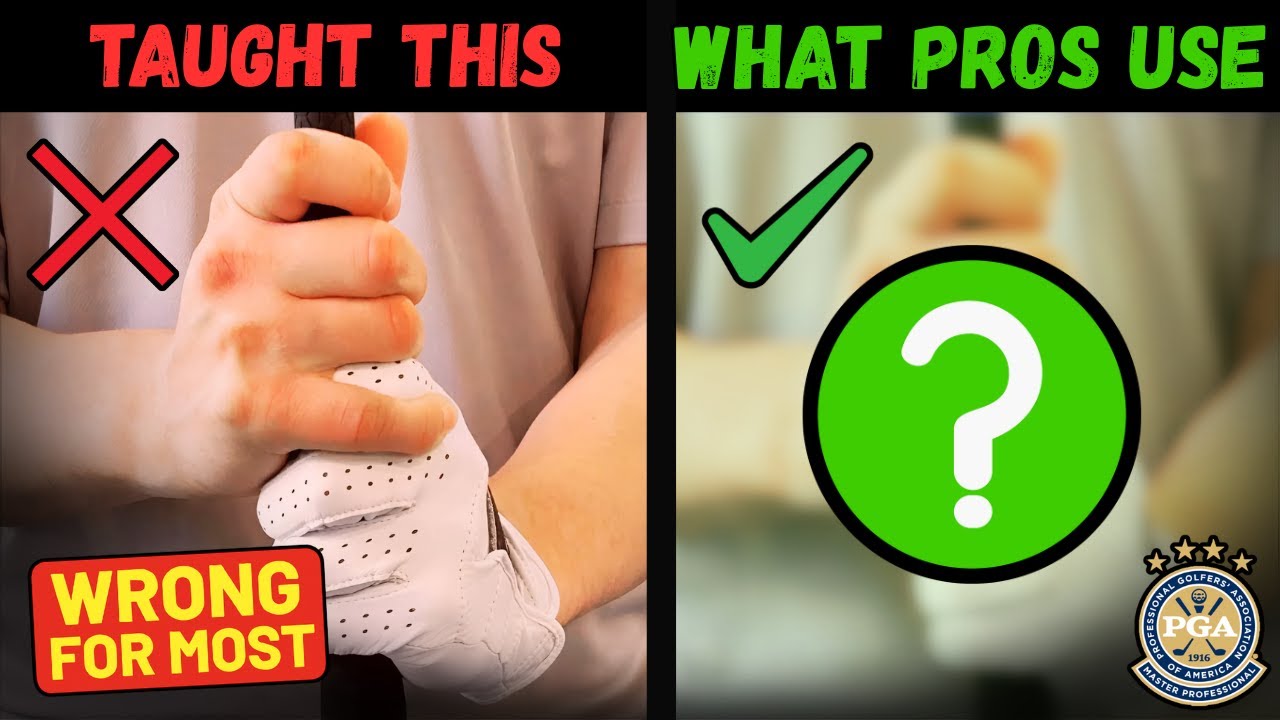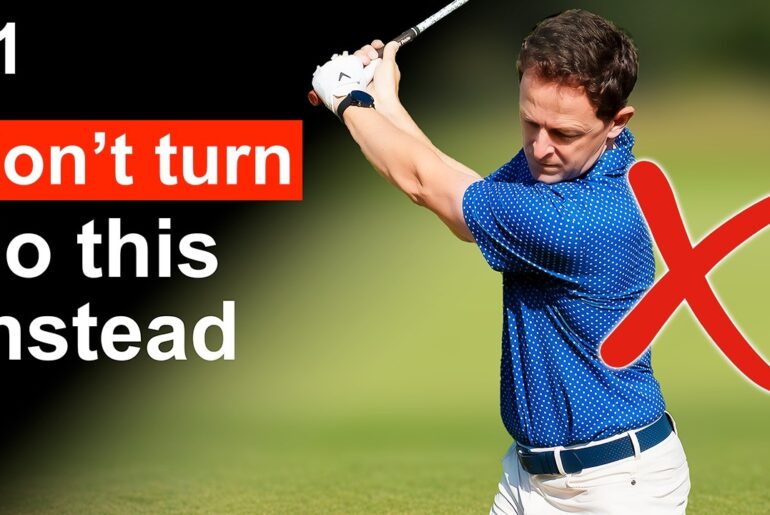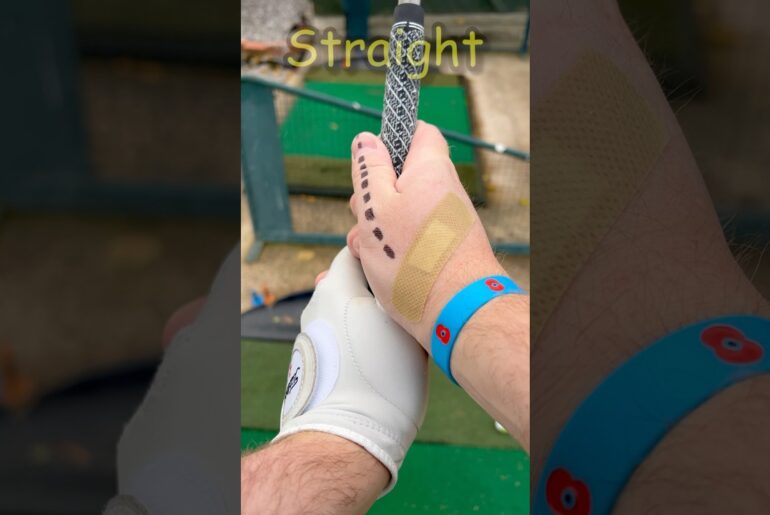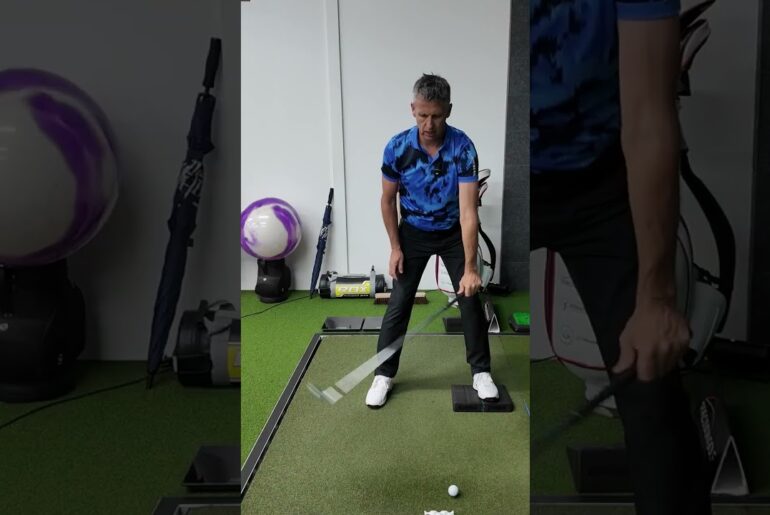You’ve been told there’s only one correct golf grip. But here’s the truth: most PGA Tour pros don’t even use the grip you were taught. In this video, I break down the real stats behind grip use on Tour, expose the outdated advice that’s still being pushed, and explain the key differences between the interlock, overlap, and 10-finger grips.
We’ll also cover:
Why interlock is now the most-used grip on Tour (and why it works)
When the 10-finger grip is actually the best option (especially for beginners)
How grip style + grip position create or limit your swing potential
What happens when you match the wrong grip to the wrong body
Because the grip isn’t just a preference—it’s a blueprint for your swing.
Get it wrong early… and your swing spends years compensating.
Get it right… and everything else gets easier.
👉 Comment below: What grip do YOU use—and why?
🎥 Join us for Sunday Red Light Live – a FREE livestream reviewing subscriber swings.
📩 Want your swing reviewed? Send your videos to: https://form.jotform.com/251687122934158
Join this channel to help support the children in Cape Flats, South Africa:
https://www.youtube.com/channel/UCaDe37093HftJsFzrmLQUZA/join
For information on our development programs around Southern California in Los Angeles, San Diego and the Coachella Valley please visit:
Follow us on Instagram
https://www.instagram.com/lion_family_golf_academies/
Follow us on Facebook:
https://www.facebook.com/lionfamilygolf
#liongolfacademy #hitthebell #subscribe
Let me start this video with this. Grips are not just a detail in the golf swing. They are a foundation. If I took three identical clones, same body, same athleticism, and same DNA, and gave each of them a different grip style and grip position, I promise you this. In 3 to 5 years, you’d have three completely different golfers. One might be on the PJ tour, one might be your local weekend warrior still chasing 90. And the third, well, let’s just say Mrs. is having camp isn’t exactly lining up to watch him tea off on Saturday. That is how powerful the grip is. And that is what this video is all about. More particularly, we’re going to break down the three major grip styles, interlock, overlap, and 10 finger. What they actually do and who they work best for, and why certain ones lead to better matchups than others. I’ll also explain why more tros today use interlock. Yes, I said it. Interlock, not overlap, and why the 10-finger grip, despite being rare on tour, might be the perfect place to start for everyday players. Interlock looks like this. Overlap looks like this. And 10 finger. Some of you know that one too well. And you might be wondering which one works best for you. Well, good, because the whole grip like the pros thing that’s been sold to you kind of backwards. It turns out the grip most people think players use isn’t even the most popular anymore. In 2024, Golf Digest reviewed all 156 players in the PJ Championship field. Every single one of them. And here’s what they found. 58.4% of those players use the interlocking grip. Only 40.9% used the overlap grip. And just one player used the 10-finger grip. So that myth, all the pros use the overlap grip, that’s dead. It’s over. It’s outdated. So why did we grow up thinking the overlap was the pro grip? Well, it’s simple. Harry Varden made it famous back in the early 1900s. Then it stuck. Sneeed used it. Ben Hogan, after experimenting with other grip styles early in his career, eventually settled on the overlap grip and featured it prominently in his five lessons. It became the textbook grip for generations. Golf magazines, instructors, and swing coaches turned it into gospel. And to be fair, it does look smooth, especially on camera. But turns out looking pretty isn’t the same thing as swinging efficiently. So the question to ask now is why do more PJ Tour pros use the interlock grip today than ever before? It’s easy to say it’s just preference, but what if it’s not that simple? Here’s a theory. A lot of these pros started swinging the club when they were five, six, maybe even younger. And at that age, they didn’t have big enough hands, strong fingers, or any real grip strength. So, what’s the most secure way to keep the club from flying out of their little tiny hands? It’s possibly the interlock would make more sense. It physically binds the hands together and creates unity. So, these juniors grew up with it. They built their swing around it thousands of reps later. Their entire DNA swing was linked to that grip. And maybe, just maybe, that interlock grip gave them better body to club matchups without even them knowing it. It promotes connection, tightens face control, and often encourages rational movement. So, the players who stuck with it didn’t even have to do anything later. They just got it right early by accident or instinct. What was the result? Survivorship bias. The ones who didn’t have to fight their grip kept going and a good chunk of them ended up on tour. So, when we say 58% of PJ Tour players use Interlock, we’re not just listing a stat. We might be looking at a natural outcome of finding a grip that asks for the fewest compensations early enough so that it becomes second nature. But let’s just talk you through each grip now without idle worship just basic function. The interlock physically locks your hands together. And this could give you better club face control and unity. It’s great if you’ve got long fingers, small hands, or if you just like to feel the club is one with your hands. The overlap or varn grip can give you more feel, more wrist independence, and a bit more flow. And it’s best for average to large hands. And you may see a soft draw or high fade depending on grip pressure positions and your sequencing. But then there’s the 10 finger grip, the most misunderstood of them all. All 10 fingers, well, eight fingers, two thumbs are on the club at the same time, like holding a baseball bat. This will give you more leverage, more surface contact, and often more power. So, if you are a beginner, if you lack grip strength, or if you’re still figuring out how to square the club face, this grip could be the game changer. It teaches hand rotation naturally. It builds confidence quickly. Does it show up in tour? Almost never. And that’s because pros don’t need the help. They have the grip strength, body mechanics, and body sequencing to make overlap or interlock more precise. The 10finger grip at tour speeds could introduce too much hand action. And that’s a consistency killer when you’re swinging at 120 miles an hour. Man, it must be nice. But for beginners or even intermediate players who feel like they’re constantly hanging on to the club, the 10 finger grip can unlock freedom, your face control, and better yet, increase your speed. But don’t let tradition shame you out of results. So just remember this, your grip is not a preference. It is a blueprint. It can dictate your wrist angles, your face control, release patterns, and swing sequencing. So if you get the wrong grip, you might be stuck building compensations forever. You get the right one, and suddenly everything can just flow. So if you’re a beginner, don’t be afraid to start with the 10 finger grip. It’s not a crutch, it’s a bridge. It’s a set of training wheels that can actually teach you how to square the club face before you worry about wrist angles, tilting, transitions, etc. But just make sure you test the others as well because when your grip matches your hand and body, everything gets a lot easier. I hope that helped you. I’ll see you guys later. Fairs and Greens. A huge thank you to these incredible supporters on the screen and to you watching this video. Your support helps us bring our golf curriculum to low-income children around the world at no cost to them. Just like our location in Cape Flat, South Africa, in partnership with the Hillard program. Please like, share, and consider subscribing. Together, we can give the gift of golf to kids who need it the most. [Music]








44 Comments
Have you ever switched grips and seen a huge change (good or bad)? Let’s hear your story👇
I've tried them all and find the overlap works best for me. Feels like my right pinky finger is breaking using the interlock.
Any thoughts on reverse overlap? Or double overlap?
I use the interlock, if my grip starts feeling off I'll switch to 10 finger or overlap for a 10 or so balls then switch back, gives me a good reset. In the past I have dabbled with the over lap for a time but I ALWAYS go back to the interlock. But as you said thats a personal preference, you just have to try them and calculate the results.
Interesting commentary! I have always used 10 finger as it was comfortable. However, I've thought about changing to interlock. Obviously, it would take some time to get used to it. I'm curious your thoughts on how much time a player should spend with a change like that before deciding "it's not right for them"? It seems logical that it will feel off initially, but could I gain better control and ultimately less dispersion? Is it worth that journey? Would love your thoughts!
Does anyone out there know which pro uses the 10-finger grip? It’s my grip of choice, but was surprised that even one pro uses it. Greetings from Down-Under.
I use an interlock grip slightly stronger. I have small hands and interlock feels best.
Nice one!
I heard another reason pros use interlock is they start so young and they learn to hook and draw the ball as they can release the club ridiculously fast. Interlock is meant to be able to calm that a bit. No idea if true though.
58% is barely statistically significant for the kind of numbers in question.
Never trust anyone with a beard.
The interlocking grip puts the pressure more on the last three fingers of the left hand.You can't use the first finger this way.That is why this grip produces alot of good players.
I've been playing for a year and have been trying all three. Despite having xxl hands, I like interlock. But lately I'm using a 10 finger grip, and it has been working well with my driver. Maybe I'll wind up switching depending on the club.
Sometimes I interlock and sometimes I overlap. It depends on how my hands are feeling and which is more comfortable that day.
It's not just the grip that influences club face, the position of the left wrist at the top plays a part, if you are like DJ or Rahmbo then the club face will be more closed, on the other hand if you are more like Hogan or Couples at the top then the face will be open.
i've tried all of em…started 10 finger, ended 10 finger. a lot of people think a baseball grip is purely in the palms, but i basically hold it the 'proper way' minus the pinky being a centimeter closer to the other hand i guess. i think the grip is something that should go into even more detail due to anatomy. i have very inflexible skinny fingers. i swear i can't do the varden/interlock no matter how much i try. it hurts when i release the club, feels awkward as hell, and i'm fighting it constantly.
Great video.
10 fingers. I used to be interlocking for my whole life. Last year, I tried 10 finger at the range. Had better control with the face and club. No turning back for me
Stong baseball ten finger grip works for me. Started with it initially, weakened it for many years, but now I'm older, gone back to it. Stock shot, a slight draw.
If you look page 27 of Hogan book you will see he has a semi! ie between overlap and interlock,works for me, (but i seem to have developed a small ball bearing like nodule at the base of my right pinkie )!
Even tho i would teach most beginners 10 finger grip
I took up golf late in life and also have large hands 3xl glove size , interlock is very difficult and actually painful so 10 fingers works for me
Right hand pinkie gets squished when i use a 10 finger grip. No idea why but it hurts like hell, best grip for consistency though just cant use it
Another great video! 👍 I started with interlock, but it hurts and one day I noticed it made my grip very firm, which led to tense forearms and restricted loose wrists too. So I switched to overlap but am not happy with that either. Never considered using baseball grip, but will give it a try some time soon. But question is: then right hand is a bit lower on the shaft. How can I avoid too much shoulder tilt in setup? Thank you for all your support.😘
Ive used reverse overlap. I absolutely smashed the ball but it did create alot of downward force on the club leading to a hook.
To my knowledge only Michael Thorbjornsen is the only Tour player currently using the 10-finger grip but he is one of the longest hitters on Tour. I've always liked it myself but got talked out of it by a "name" teacher around 15 years ago.
Ten Finger Here!
I played baseball most of my younger years and the baseball grip is my default.
I have shorter fingers so I have to use the 10 finger baseball grip
And then there's the Alex Morrison grip. Alex taught Jack Grout and he influenced Jack Nicklaus. Alex taught Henry Picard who in turn influenced Ben Hogan. So there is some pedigree. His grip shows an interlock grip with the lead hand thumb down the back of the shaft instead of on top and snuggles the trail hand into a closer relationship with the lead hand. Guarantee no-one uses it today because it's not fashionable, not because it doesn't work.
Started with interlock, then overlap, now 10 finger. I did it backwards lol, but pain motivated and comfortable now
I started with ten finger grip then whent to interlock then overlap which I used many years but changed back to interlock a few years ago.
I believe interlock keeps the hands working together better than the overlap as I had a tendency for the grip to change on the backswing.
Yep 10 fingers. I never could do the over lap and sustain consistency. However, that’s how I was taught. Everybody is different though.
Hi Tony, a teacher once told me a similar thing about pivots…it mattered whether you were “front wheel drive”, “rear wheel drive” or “all wheel drive”…what are your thoughts about different pivots?
I started playing golf right handed and the interlocking grip felt more natural. After a year of struggling to play right handed mostly because of availability of left handed clubs I found a set of left handed clubs and the overlapping grip felt more natural. Tried interlocking but just doesn’t feel right.
most to todays PGATour grew up watching/idolizing Tiger who interlocks
I truly think the growth of the interlocking grip was due to all of these players growing up watching Tiger. Jack played with an interlocking grip but golf was rarely on TV in the 70’s and young players learned more from club pros and magazines that promoted the overlapping grip.
I play at a 4 hdcp interlocking works for me the club feels the most secure in my hands
I’ve been playing 53 years. In the last five years or so I don’t think I’ve seen any amateur using the overlap. When I started playing in 1972 it was THE grip, but I was a student of Nicklaus.
I’m trying to think of any other sport using a bat, a racket or similar where you wouldn’t hold it either with one hand or baseball style two handed.
Used to use overlap because interlock hurt my fingers.
Now after a car accident and broken index finger the interlock works now 🤷🏼
Can't close left index though, but loved it on the course.
Have you ever checked out Mike Maves ( Sevam1 )?
I think it would make for an interesting breakdown.
He was linked up with Steve Elkington years ago.
Curious to understand in depth how to gauge which grip string weak or in between is best for each individual 🙂
Fairly new subscriber. Love your content. I just realized who you remind me of. Respectfully, "If Mitch Hedberg was a golf instructor". ⛳️
I use overlap, simply because it feels more comfortable. What ever keeps those hands working together. 10 finger grip is perfectly fine as long as the player prefents their hands working against eachother!
Yep, smaller guy, have essentially used overlap since I started a few years ago. As of recent, started using interlock, have to say, face control has been quite a bit better. When I go back to the range, going to record a swing for you dissect. Been fan of that series, have a great weekend!